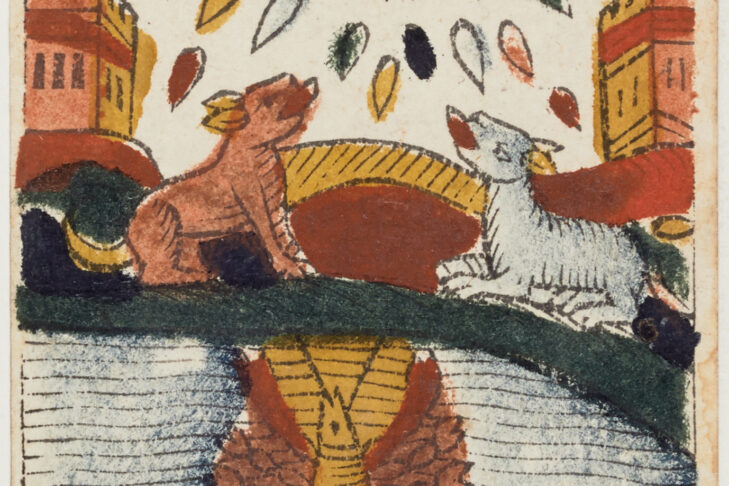Art d’var: Commentary on Torah through a related work of art. Just as Torah is a framework for Jewish life that must be unpacked and investigated from many angles to understand the depth of its content and applicability to our own lives, so is great art. This series illuminates works of art that help contemporize the ancient text of the Torah.
Passover
Exodus 12:21-51
Numbers 28:16-25
There are just a few times a year we take a break from the regularly scheduled weekly Torah portion. This week, Passover is one of those special weeks because we read the portions from both the books of Exodus and Numbers that tell the Passover story of the Israelites in Egypt and the Exodus.
In this special edition of the Art D’var, I’m looking toward a project called “Torah in the Tarot” to give us a whole new way to see the Passover story.
At face value, the moon card of the Tarot de Marseilles deck is a beautiful example of a standard component of the 22-card arcana.
But when you look at the card through the lens of a theory that has been heavily researched by Torah scholar Stav Appel, you may suddenly notice:
- Bands of what could be blood cross the two buildings that flank the card, reminiscent of blood on a doorpost
- A “langosta,” or lobster, a word that in French means both “lobster” and “locust,” harkening to the eighth of the 10 plagues
- The red strip behind the dogs, resembling the river of blood that flowed through Egypt
- Three rounds of matzah popping out from the bottom
- Dogs barking, because as it’s said in the portion that, concerning the Israelites’ departure from Egypt, God promises that the Exodus will be so unopposed that “not even a dog will bark…” (Exodus 11:7)
And once you see those, you quickly realize that you can find imagery of the entire Exodus story as you scan across the card. And beyond that, you may also notice a Hebrew letter toward the bottom—a “mem.”
This moon card is one of 22 in the Tarot de Marseilles deck that illustrate Jewish holidays and traditions—each of the 22 cards also features one of 22 Hebrew letters. And while each letter is visible, once you know where to look, they are all intended to be concealed and revealed.
“Torah in the Tarot” explores this theory, that the Tarot de Marseille, one of the original decks of tarot cards created in 1650, was created by Crypto-Jews—Jews living in and around Spain and France who, due to antisemitism, were forced to mask their Jewish identities and traditions.
If you believe this theory, the story that’s described in this card is the ultimate Jewish story. Through the card imagery, the Passover Exodus story hides in plain sight—a story core to the Passover story when we think about the fact that Moses was positioned to rescue the Israelites from Egypt because he was hidden in plain sight as the son of Pharaoh’s daughter.
Despite the Exodus from Egypt, and thousands of years and moments of persecution of the Jewish people that we know is to follow, Jewish life and traditions have continued to find ways over more than 5,000 years to stay alive and relevant—oftentimes hiding more in plain sight—visible to those who know how to look.
As theorist Stav Appel writes: “In the long and troubled history of the Jewish people, the year 1650 was a moment of exceptional despair. The presence of Jews remained entirely forbidden in Spain, France, England, Portugal…. The surviving remnant of Italian Jewish life was entirely imprisoned in ghettos. In Eastern Europe, Ukrainian Cossacks were inflicting massacres and slaughter on Poland’s emerging Ashkenazi Jewish population. The Holy Office of the Inquisition continued to hunt down and publicly execute New Christians discovered practicing Judaism in secret. A widely discussed prophecy of divine redemption hinted at in the Zohar for the year 1648 proved empty. Many began to openly question whether the Jewish faith would continue to exist at all.”
Approximately in the year 1650, an artist in Paris created the Jean Noblet Tarot de Marseille.
Coming in fall 2022, “Torah in the Tarot” will have an accompanying app called “Secrets of the Tarot,” an augmented reality (AR) phone app that enlivens the “Torah in the Tarot” cards and tells the story as an animated short film.
Read more about the inception of “Secrets of the Tarot” here.
As we say at the end of the seder, “Next year in Jerusalem,” I will say, “Next year in AR”—a space where we can all encounter the Passover story in exciting new ways.
This post has been contributed by a third party. The opinions, facts and any media content are presented solely by the author, and JewishBoston assumes no responsibility for them. Want to add your voice to the conversation? Publish your own post here. MORE



